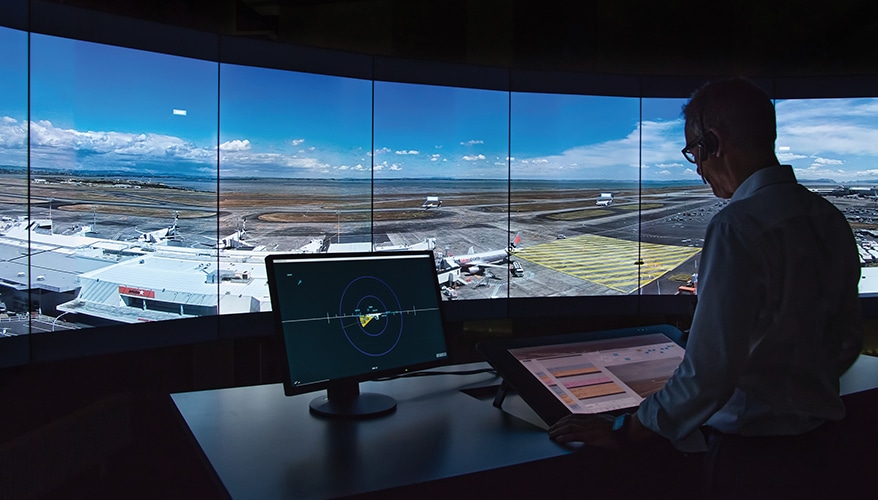Airport
World’s first Remote Digital ATC London

World’s first Remote Digital ATC: Following extensive tests and live demonstrations of the advanced system during the lockdown, London City Airport has become the world’s first major international airport to be directly controlled by a remote digital air traffic control tower.
All flights on the summer schedule are directed to land or take off from the heart of the London Docklands business district by air traffic controllers located 115 kilometers away at NATS’ air traffic control center in Swanwick, Hampshire, using an ‘enhanced reality’ view provided by a state-of-the-art 50m digital control tower.
The technology represents a significant advancement in global air traffic management and will assist the airport in meeting an anticipated increase in demand for flying during the summer season, as COVID-19 restrictions are lifted on Monday, May 17th.
Following the completion of new aircraft stands and a full-length parallel taxiway, which became operational in December 2020, the multi-million-pound investment in tested remote digital technology marks a significant milestone in City Airport’s investment in its future.
“We are immensely proud to become the first major international airport to adopt this pioneering technology. […] It is also a demonstration of the commitment to innovation in the UK aviation sector and to being at the forefront of defining the future of flight,” said Alison FitzGerald, Chief Operating Officer at London City Airport.
The digital control tower at London City Airport was completed in 2019 and has undergone rigorous testing before being fully operational. The airport’s expansion program would include the redevelopment of the 30-year-old analog tower, which was scheduled for a major update.

Airport
Top 10 Largest Airports in the World by Size

When it comes to the world’s busiest and largest airports, size matters—not just in terms of the area they cover, but also in the volume of passengers they handle and the number of flights they accommodate.
As air travel continues to grow, airports around the globe are expanding and upgrading to meet increasing demand.
Qatar Airways Announces New Flights to Hamburg, resume services to Venice:Click
In 2024, several airports stand out for their impressive size and capacity. This article takes a closer look at these massive aviation hubs, highlighting their key features and what makes them the largest airports in the world today.
Country Airport Area (sq km) Saudi Arabia King Fahd International Airport 776 United States Denver International Airport 135 Malaysia Kuala Lumpur International Airport 100 Turkey Istanbul Airport 76 China Beijing Daxing International Airport 46 Egypt Cairo International Airport 36 Thailand Suvarnabhumi Airport 32 Spain Adolfo Suárez Madrid-Barajas Airport 30 Canada Edmonton International Airport (YEG) 28 Netherlands Amsterdam Airport Schiphol 27 Australia Brisbane International Airport 27 Germany Frankfurt Airport 23 India Rajiv Gandhi International Airport 22
King Fahd International Airport, Saudi Arabia – Spanning a staggering 776 square kilometers, King Fahd International Airport is the largest airport in the world by area. Its vast expanse reflects its crucial role as a major hub in the Middle East.
Denver International Airport, United States – Covering 135 square kilometers, Denver International Airport ranks second in size. Known for its distinctive peaked roof and extensive facilities, it serves as a major gateway in North America.
Kuala Lumpur International Airport, Malaysia – With an area of 100 square kilometers, Kuala Lumpur International Airport is a key international hub in Southeast Asia, offering extensive services and connectivity.
Top 10 Busiest Airports in the World for 2023:Click here
Istanbul Airport, Turkey – Istanbul Airport covers 76 square kilometers. This relatively new airport has quickly become one of the largest and busiest, positioning itself as a central point for travel between Europe and Asia.
Beijing Daxing International Airport, China – Beijing Daxing International Airport, with 46 square kilometers, is one of the newest major airports, featuring an impressive design and extensive facilities to handle growing passenger traffic.
-

 Travel1 week ago
Travel1 week agoAir India to Expand US Operations with Three New Routes After a Decade
-

 Travel2 weeks ago
Travel2 weeks agoWhy We Should Avoid These Stamps in a Passport
-

 Airlines1 month ago
Airlines1 month agoInvestigations Reveal Fake Chinese Titanium in Boeing and Airbus Jets
-

 Tech4 weeks ago
Tech4 weeks agoChina’s CATL Plans 1,800-Mile Electric Plane Launch by 2027
-

 Airport3 days ago
Airport3 days agoTop 10 Largest Airports in the World by Size
-

 Aerospace4 weeks ago
Aerospace4 weeks agoChina’s Fighter Jets Turn Wings into Autonomous Drones
-

 Airlines4 days ago
Airlines4 days agoAir India Rolls Out A350s for Delhi-New York JFK and Newark Routes
-

 Defence3 weeks ago
Defence3 weeks agoBoeing Enhances Chinook with New Engines and Block II Upgrades at $96 Million







